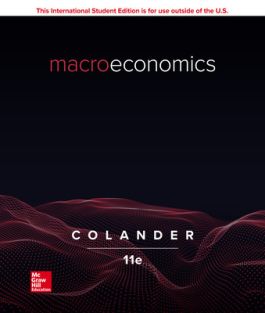Macroeconomics ISE
11th Edition
1260568822
·
9781260568820
© 2020 | Published: January 18, 2019
Colander’s Macroeconomics 11e is specifically designed to help today’s students succeed in their principles of economics course and grasp economics concepts that they can apply in their daily lives. Colander’s trademark colloquial approach focu…
Read More
After purchasing your eBook, login to the McGraw Hill Bookshelf website and redeem the access code from your order confirmation email.
- Access your eBook online or offline
- Easily highlight and take notes
- Fully searchable content
- Syncs across platforms
NOTE: eBook purchase does not include Connect homework or adaptive SmartBook assignments
PART 1: INTRODUCTION: THINKING LIKE AN ECONOMIST
1 Economics and Economic Reasoning
2 The Production Possibilities Model, Trade, and Globalization
3 Economic Institutions
4 Supply and Demand
5 Using Supply and Demand
PART II: MACROECONOMICS
MACROECONOMIC BASICS
6 Economic Growth, Business Cycles, and Unemployment
7 Measuring and Describing the Aggregate Economy
POLICY MODELS
8 The Keynesian Short-Run Policy Model: Demand-Side Policies
8W The Multiplier Model
9 The Classical Long-Run Policy Model: Growth and Supply-Side Policies
FINANCE, MONEY, AND THE ECONOMY
10 The Financial Sector and the Economy
11 Monetary Policy
12 Financial Crises, Panics, and Unconventional Monetary Policy
TAXES, BUDGETS, AND FISCAL POLICY
13 Deficits and Debt: The Austerity Debate
14 The Fiscal Policy Dilemma
MACROECONOMIC PROBLEMS
15 Jobs and Unemployment
16 Inflation, Deflation, and Macro Policy
INTERNATIONAL MACROECONOMIC POLICY ISSUES
17 Comparative Advantage, Exchange Rates, and Globalization
18 International Trade Policy
19 International Financial Policy
20 Macro Policy in a Global Setting
21 Structural Stagnation and Globalization
22 Macro Policy in Developing Countries
1 Economics and Economic Reasoning
2 The Production Possibilities Model, Trade, and Globalization
3 Economic Institutions
4 Supply and Demand
5 Using Supply and Demand
PART II: MACROECONOMICS
MACROECONOMIC BASICS
6 Economic Growth, Business Cycles, and Unemployment
7 Measuring and Describing the Aggregate Economy
POLICY MODELS
8 The Keynesian Short-Run Policy Model: Demand-Side Policies
8W The Multiplier Model
9 The Classical Long-Run Policy Model: Growth and Supply-Side Policies
FINANCE, MONEY, AND THE ECONOMY
10 The Financial Sector and the Economy
11 Monetary Policy
12 Financial Crises, Panics, and Unconventional Monetary Policy
TAXES, BUDGETS, AND FISCAL POLICY
13 Deficits and Debt: The Austerity Debate
14 The Fiscal Policy Dilemma
MACROECONOMIC PROBLEMS
15 Jobs and Unemployment
16 Inflation, Deflation, and Macro Policy
INTERNATIONAL MACROECONOMIC POLICY ISSUES
17 Comparative Advantage, Exchange Rates, and Globalization
18 International Trade Policy
19 International Financial Policy
20 Macro Policy in a Global Setting
21 Structural Stagnation and Globalization
22 Macro Policy in Developing Countries
Colander’s Macroeconomics 11e is specifically designed to help today’s students succeed in their principles of economics course and grasp economics concepts that they can apply in their daily lives.
Colander’s trademark colloquial approach focuses on modern economics, institutions, history, and modelling. Colander presents and applies economic models, but also encourages students to think about model nuances, building their critical thinking skills and applying models to the real world.
Content in Macroeconomics 11e is organised around learning objectives, to make it easier for students to understand the material covered and for instructors to build assignments within the Connect platform. Through Connect and SmartBook, students will find engaging activities, helpful tutorial videos, and learning resources as they need them.
Colander’s trademark colloquial approach focuses on modern economics, institutions, history, and modelling. Colander presents and applies economic models, but also encourages students to think about model nuances, building their critical thinking skills and applying models to the real world.
Content in Macroeconomics 11e is organised around learning objectives, to make it easier for students to understand the material covered and for instructors to build assignments within the Connect platform. Through Connect and SmartBook, students will find engaging activities, helpful tutorial videos, and learning resources as they need them.

